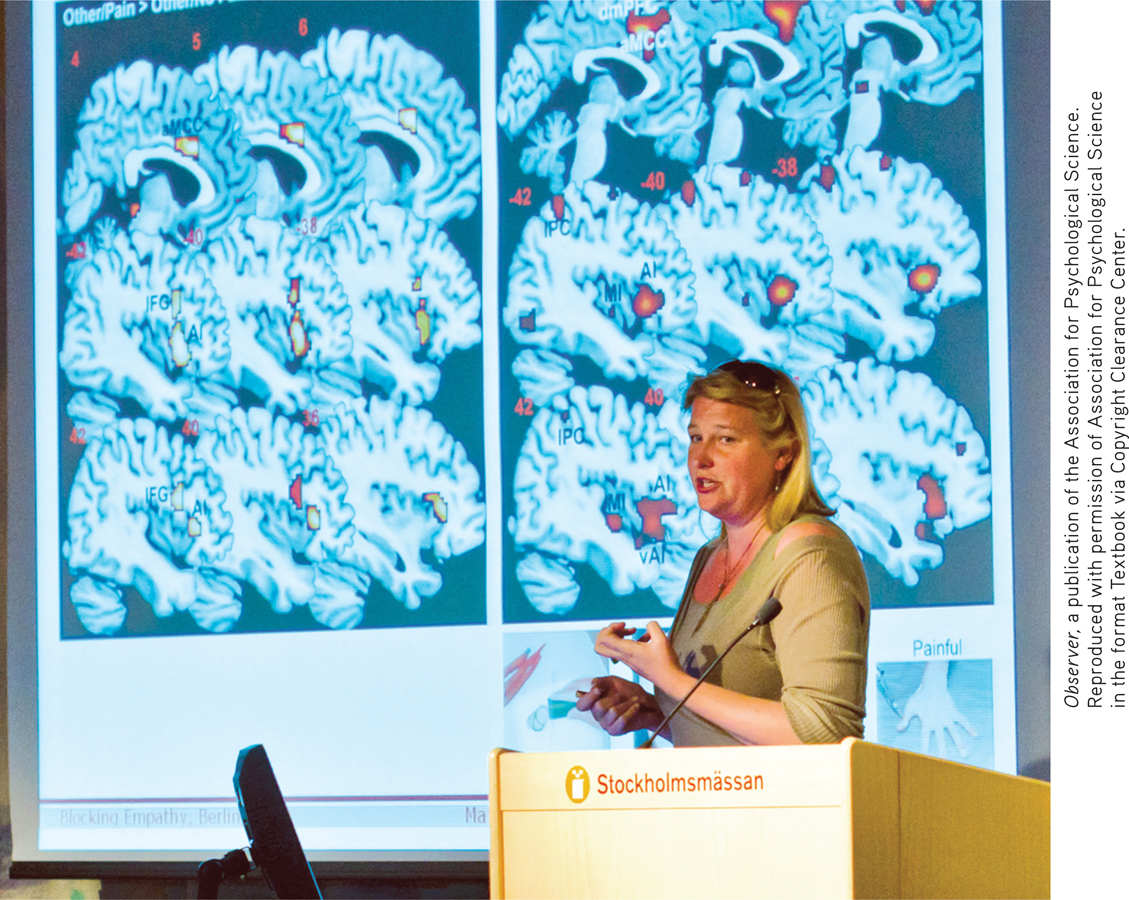1.2 Contemporary Psychology
KEY THEME
As psychology has developed as a scientific discipline, the topics it investigates have become progressively more diverse.
KEY QUESTIONS
How do the perspectives in contemporary psychology differ in emphasis and approach?
How do psychiatry and psychology differ, and what are psychology’s major specialty areas?
Over the past half-century, the range of topics in psychology has become progressively more diverse. And, as psychology’s knowledge base has increased, psychology itself has become more specialized. Rather than being dominated by a particular approach or school of thought, today’s psychologists tend to identify themselves according to: (1) the perspective they emphasize in investigating psychological topics and (2) the specialty area in which they have been trained and practice.
Major Perspectives in Psychology
Any given topic in contemporary psychology can be approached from a variety of perspectives. Each perspective discussed here represents a different emphasis or point of view that can be taken in studying a particular behavior, topic, or issue. As you’ll see in this section, the influence of the early schools of psychology is apparent in the first four perspectives that characterize contemporary psychology.
THE BIOLOGICAL PERSPECTIVE
As we’ve already noted, physiology has played an important role in psychology since it was founded. Today, that influence continues, as is shown by the many psychologists who take the biological perspective. The biological perspective emphasizes studying the physical bases of human and animal behavior, including the nervous system, endocrine system, immune system, and genetics. More specifically, neuroscience refers to the study of the nervous system, especially the brain.
neuroscience
The study of the nervous system, especially the brain.
Advances in medicine and technology have reinforced interest in the biological perspective. The discovery of drugs that helped control the symptoms of severe psychological disorders sparked questions about the interaction among biological factors and human behavior, emotions, and thought processes.

Equally important have been technological advances that have allowed psychologists and other researchers to explore the human brain as never before. The development of sophisticated brain-scanning techniques, including the PET scan, MRI scan, and functional MRI (fMRI) scan, allowed neuroscientists to study the structure and activity of the intact, living brain. Later in the chapter, we’ll describe these brain-imaging techniques and identify how psychologists use them as research tools.
THE PSYCHODYNAMIC PERSPECTIVE
The key ideas and themes of Freud’s landmark theory of psychoanalysis continue to be important among many psychologists, especially those working in the mental health field. As you’ll see in Chapter 11 on personality and Chapter 15 on therapies, many of Freud’s ideas have been expanded or modified by his followers. Today, psychologists who take the psychodynamic perspective may or may not follow Freud or take a psychoanalytic approach. However, they do tend to emphasize the importance of unconscious influences, early life experiences, and interpersonal relationships in explaining the underlying dynamics of behavior or in treating people with psychological problems.

THE BEHAVIORAL PERSPECTIVE
Watson and Skinner’s contention that psychology should focus on observable behaviors and the fundamental laws of learning is evident today in the behavioral perspective. Contemporary psychologists who take the behavioral perspective continue to study how behavior is acquired or modified by environmental causes. Many psychologists who work in the area of mental health also emphasize the behavioral perspective in explaining and treating psychological disorders. In Chapter 5 on learning and Chapter 15 on therapies, we’ll discuss different applications of the behavioral perspective.
THE HUMANISTIC PERSPECTIVE
The influence of the work of Carl Rogers and Abraham Maslow continues to be seen among contemporary psychologists who take the humanistic perspective (Serlin, 2012; Waterman, 2013). The humanistic perspective focuses on the motivation of people to grow psychologically, the influence of interpersonal relationships on a person’s self-concept, and the importance of choice and self-direction in striving to reach one’s potential. Like the psychodynamic perspective, the humanistic perspective is often emphasized among psychologists working in the mental health field. You’ll encounter the humanistic perspective in the chapters on motivation (8), personality (11), and therapies (15).
THE POSITIVE PSYCHOLOGY PERSPECTIVE
The humanistic perspective’s emphasis on psychological growth and human potential contributed to the recent emergence of a new perspective. Positive psychology is a field of psychological research and theory focusing on the study of positive emotions and psychological states, positive individual traits, and the social institutions that foster those qualities in individuals and communities (Csikszentmihalyi & Nakamura, 2011; Peterson, 2006; Seligman & others, 2005). By studying the conditions and processes that contribute to the optimal functioning of people, groups, and institutions, positive psychology seeks to counterbalance psychology’s traditional emphasis on psychological problems and disorders (McNulty & Fincham, 2012).
positive psychology
The study of positive emotions and psychological states, positive individual traits, and the social institutions that foster positive individuals and communities.
Topics that fall under the umbrella of positive psychology include personal happiness, optimism, creativity, resilience, character strengths, and wisdom. Positive psychology is also focused on developing therapeutic techniques that increase personal well-being rather than just alleviating the troubling symptoms of psychological disorders (Snyder & others, 2011). Insights from positive psychology research will be evident in many chapters, including the chapters on motivation and emotion (8); personality (11); stress, health, and coping (13); and therapies (15).
THE COGNITIVE PERSPECTIVE
During the 1960s, psychology experienced a return to the study of how mental processes influence behavior. Often referred to as “the cognitive revolution” in psychology, this movement represented a break from traditional behaviorism. Cognitive psychology focused once again on the important role of mental processes in how people process and remember information, develop language, solve problems, and think.
The development of the first computers in the 1950s contributed to the cognitive revolution. Computers gave psychologists a new model for conceptualizing human mental processes—human thinking, memory, and perception could be understood in terms of an information-processing model. We’ll consider the cognitive perspective in several chapters, including Chapter 7 on thinking, language, and intelligence. The cognitive perspective has also influenced other areas of psychology, including personality (Chapter 11) and psychotherapy (Chapter 15).
THE CROSS-CULTURAL PERSPECTIVE

More recently, psychologists have taken a closer look at how cultural factors influence patterns of behavior—the essence of the cross-cultural perspective. By the late 1980s, cross-cultural psychology had emerged in full force as large numbers of psychologists began studying the diversity of human behavior in different cultural settings and countries (Kitayama & Uskul, 2011; P. Smith, 2010). In the process, psychologists discovered that some well-established psychological findings were not as universal as they had thought.
For example, one well-established psychological finding was that people exert more effort on a task when working alone than when working as part of a group, a phenomenon called social loafing. First demonstrated in the 1970s, social loafing was a consistent finding in several psychological studies conducted with American and European subjects. But when similar studies were conducted with Chinese participants, the opposite was found to be true (Hong & others, 2008). Chinese participants worked harder on a task when they were part of a group than when they were working alone.
Today, psychologists are keenly attuned to the influence of cultural factors on behavior (Heine, 2010; Henrich & others, 2010). Although many psychological processes are shared by all humans, it’s important to keep in mind that there are cultural variations in behavior. Thus, we have included Culture and Human Behavior boxes throughout this textbook to help sensitize you to the influence of culture on behavior—including your own. We describe cross-cultural psychology in more detail in the Culture and Human Behavior box below.
CULTURE AND HUMAN BEHAVIOR
What Is Cross-Cultural Psychology?
All cultures are simultaneously very similar and very different.
—Harry Triandis (2005)
People around the globe share many attributes: We all eat, sleep, form families, seek happiness, and mourn losses. Yet the way in which we express our human qualities can vary considerably among cultures. What we eat, where we sleep, and how we form families, define happiness, and express sadness can differ greatly in different cultures.
Culture is a broad term that refers to the attitudes, values, beliefs, and behaviors shared by a group of people and communicated from one generation to another (Cohen, 2009, 2010). When this broad definition is applied to people throughout the world, about 4,000 different cultures can be said to exist. Studying the differences among those cultures and the influences of culture on behavior are the fundamental goals of cross-cultural psychology.
culture
The attitudes, values, beliefs, and behaviors shared by a group of people and communicated from one generation to another.
cross-cultural psychology
Branch of psychology that studies the effects of culture on behavior and mental processes.
A person’s sense of cultural identity is influenced by such factors as ethnic background, nationality, race, religion, and language. As we grow up within a given culture, we learn our culture’s norms, or unwritten rules of behavior. Once those cultural norms are understood and internalized, we tend to act in accordance with them without too much thought. For example, according to the dominant cultural norms in the United States, infants and toddlers are not supposed to routinely sleep in the same bed as their parents. In many other cultures around the world, however, it’s taken for granted that babies will sleep in the same bed as their parents or other adult relatives (Mindell & others, 2010a, b). Members of these other cultures are often surprised and even shocked at the U.S. practice of separating babies from their parents at night. (In the Culture and Human Behavior box in Chapter 9, we discuss this topic at greater length.)
Whether considering sleeping habits or hairstyles, most people share a natural tendency to accept their own cultural rules as defining what’s “normal.” This tendency to use your own culture as the standard for judging other cultures is called ethnocentrism. Although it may be a natural tendency, ethnocentrism can lead to the inability to separate ourselves from our own cultural backgrounds and biases so that we can understand the behaviors of others (Bizumic & others, 2009). Ethnocentrism may also prevent us from being aware of how our behavior has been shaped by our own culture.
ethnocentrism
The belief that one’s own culture or ethnic group is superior to all others and the related tendency to use one’s own culture as a standard by which to judge other cultures.
Some degree of ethnocentrism is probably inevitable, but extreme ethnocentrism can lead to intolerance toward other cultures. If we believe that our way of seeing things or behaving is the only proper one, other ways of behaving and thinking may seem not only foreign, but also ridiculous, inferior, wrong, or immoral.
In addition to influencing how we behave, culture affects how we define our sense of self (Markus & Kitayama, 1991, 1998, 2010). For the most part, the dominant cultures of the United States, Canada, Australia, New Zealand, and Europe can be described as individualistic cultures. Individualistic cultures emphasize the needs and goals of the individual over the needs and goals of the group (Henrich, 2014; Markus & Kitayama, 2010). In individualistic societies, social behavior is more strongly influenced by individual preferences and attitudes than by cultural norms and values. In such cultures, the self is seen as independent, autonomous, and distinctive. Personal identity is defined by individual achievements, abilities, and accomplishments.
individualistic cultures
Cultures that emphasize the needs and goals of the individual over the needs and goals of the group.

In contrast, collectivistic cultures emphasize the needs and goals of the group over the needs and goals of the individual. Social behavior is more heavily influenced by cultural norms and social context than by individual preferences and attitudes (Owe & others, 2013; Talhelm & others, 2014). In a collectivistic culture, the self is seen as being much more interdependent with others. Relationships with others and identification with a larger group, such as the family or tribe, are key components of personal identity. The cultures of Asia, Africa, and Central and South America tend to be collectivistic. According to cross-cultural psychologist Harry Triandis (2005), about two-thirds of the world’s population live in collectivistic cultures.
collectivistic cultures
Cultures that emphasize the needs and goals of the group over the needs and goals of the individual.
The distinction between individualistic and collectivistic societies is useful in cross-cultural psychology. Nevertheless, psychologists are careful not to assume that these generalizations are true of every member or every aspect of a given culture (Kitayama & Uskul, 2011). Most cultures are neither completely individualistic nor completely collectivistic, but fall somewhere between the two extremes. Equally important, psychologists recognize that there is a great deal of individual variation among the members of every culture (Heine & Norenzayan, 2006). It’s important to keep that qualification in mind when cross-cultural findings are discussed, as they will be throughout this book.
The Culture and Human Behavior boxes that we have included in this book will help you learn about human behavior in other cultures. They will also help you understand how culture affects your behavior, beliefs, attitudes, and values as well. We hope you will find this feature both interesting and enlightening!

Steve Prezant/Corbis
THE EVOLUTIONARY PERSPECTIVE
Evolutionary psychology refers to the application of the principles of evolution to explain psychological processes and phenomena (Buss, 2009, 2011b). The evolutionary perspective reflects a renewed interest in the work of English naturalist Charles Darwin. As noted previously, Darwin’s (1859) first book on evolution, On the Origin of Species, played an influential role in the thinking of many early psychologists.
evolutionary psychology
The application of principles of evolution, including natural selection, to explain psychological processes and phenomena.
The theory of evolution proposes that the individual members of a species compete for survival. Because of inherited differences, some members of a species are better adapted to their environment than are others. Organisms that inherit characteristics that increase their chances of survival in their particular habitat are more likely to survive, reproduce, and pass on their characteristics to their offspring. But individuals that inherit less useful characteristics are less likely to survive, reproduce, and pass on their characteristics. This process reflects the principle of natural selection: The most adaptive characteristics are “selected” and perpetuated in the next generation.
Psychologists who take the evolutionary perspective assume that psychological processes are also subject to the principle of natural selection. As David Buss (2008) writes, “An evolved psychological mechanism exists in the form that it does because it solved a specific problem of survival or reproduction recurrently over evolutionary history.” That is, those psychological processes that helped individuals adapt to their environments also helped them survive, reproduce, and pass those abilities on to their offspring (Confer & others, 2010). However, as you’ll see in later chapters, some of those processes may not necessarily be adaptive in our modern world (Loewenstein, 2010; Tooby & Cosmides, 2008).
Specialty Areas in Psychology
Many people think that psychologists primarily diagnose and treat people with psychological problems or disorders. In fact, psychologists who specialize in clinical psychology are trained in the diagnosis, treatment, causes, and prevention of psychological disorders, leading to a doctorate in clinical psychology.
In contrast, psychiatry is a medical specialty. A psychiatrist has earned a medical degree, either an M.D. or D.O., followed by several years of specialized training in the treatment of mental disorders. As physicians, psychiatrists can hospitalize people, order biomedical therapies such as electroconvulsive therapy (ECT), and prescribe medications. Clinical psychologists are not medical doctors and cannot order medical treatments. However, a few states have passed legislation allowing clinical psychologists to prescribe medications after specialized training (McGrath, 2010).
psychiatry
Medical specialty area focused on the diagnosis, treatment, causes, and prevention of mental and behavioral disorders.
As you’ll learn, contemporary psychology is a very diverse discipline that ranges far beyond the treatment of psychological problems. This diversity is reflected in FIGURE 1.1, which shows the range of specialty areas and employment settings for psychologists. TABLE 1.1 provides a brief overview of psychology’s most important specialty areas.

Source: Data from Finno & others (2006); NSF/NIH/USED/USDA/NEH/NASA, 2009 Survey of Earned Doctorates.
Major Specialties in Psychology
| Specialty | Major Focus |
|---|---|
| Biological psychology | Relationship between psychological processes and the body’s physical systems; neuroscience refers specifically to the brain and the rest of the nervous system. |
| Clinical psychology | Causes, diagnosis, treatment, and prevention of psychological disorders. |
| Cognitive psychology | Mental processes, including reasoning and thinking, problem solving, memory, perception, mental imagery, and language. |
| Counseling psychology | Helping people adjust, adapt, and cope with personal and interpersonal challenges; improving well-being, alleviating distress and maladjustment, and resolving crises. |
| Developmental psychology | Physical, social, and psychological changes that occur at different ages and stages of the life span. |
| Educational psychology | Applying psychological principles and theories to methods of learning. |
| Experimental psychology | Basic psychological processes, including sensory and perceptual processes, and principles of learning, emotion, and motivation. |
| Health psychology | Psychological factors in the development, prevention, and treatment of illness; stress and coping; promoting health-enhancing behaviors. |
| Industrial/Organizational psychology | The relationship between people and work. |
| Personality psychology | The nature of human personality, including the uniqueness of each person, traits, and individual differences. |
| Social psychology | How an individual’s thoughts, feelings, and behavior are affected by their social environments and by the presence of other people. |
| School psychology | Applying psychological principles and findings in primary and secondary schools. |
| Applied psychology | Applying the findings of basic psychology to diverse areas; examples include sports psychology, media psychology, forensic psychology, rehabilitation psychology. |
CONCEPT REVIEW 1.2
Identifying Perspectives and Specialties
For each of the following psychologists’ statements, fill in the blanks, identifying the perspective and specialty area.
Question 1.6
| 1. | I study brain development in infants. |
Perspective
Specialty
Question 1.7
| 2. | I compare problem-solving strategies in the United States and China. |
Perspective
Specialty
Question 1.8
| 3. | I develop programs to help people modify unhealthy eating habits, focusing on the environmental cues that trigger overeating. |
Perspective
Specialty
Question 1.9
| 4. | I investigate the early life experiences of people who seek psychotherapy for symptoms of depression. |
Perspective
Specialty
Question 1.10
| 5. | I compare mate selection patterns in primitive and modern societies. |
Perspective
Specialty
Question 1.11
| 6. | I am currently studying the role that forgiveness plays in family relationships. I want to examine the extent to which forgiveness fosters the development of a healthy family environment and positive individual traits. |
Perspective
Specialty
Test your understanding of Contemporary Psychology with
 .
.